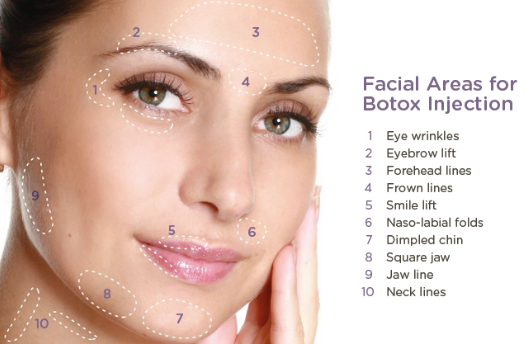Anti-Wrinkle Treatment
BOTULINUM TOXIN (BOTOX)
Millions of people around the world use anti - wrinkle treatments to enhance facial aesthetics. Botulinum Toxin (Botox TM) injections have been safely and effectively used for over 15 years in the UK. Anti-wrinkle injections are used to minimize the appearance of frown lines between the eyes, forehead lines and crows feet.
Line & wrinkle treatments have revolutionized the cosmetic industry due to their remarkable results combined with very few risks and no recovery time. A very small amount of Botulinum Toxin is injected into the desired area with a very fine needle and only a tiny amount of liquid is used resulting in minimal pain. It is an outpatient procedure and there is no need for any local anaesthetic. Following the procedure you can resume normal daily activities immediately. Results will be apparent within a week and results should last 2-6 months.

FREQUENTLY ASKED QUESTIONS
BOTOX PATIENT INFORMATION SHEET
The aim of this information sheet is to ensure that you understand the nature of the treatment you wish to undertake. Please read it carefully and discuss any queries with your practitioner.
What is botulinum toxin?
Botulinum toxin is a chemical produced by bacterium clostridium botulinum. Botox® is a protein derivative of the toxin, which when injected into a muscle causes it to become weakened or inactivated. It stops the muscle from functioning by blocking neuromuscular transmission — i.e. it stops the chemical messages from the nerve to the muscle.
How does it work?
By using facial muscles repeatedly throughout a lifetime the skin is creased in our areas of
greatest use. The ageing process causes the slow down of collagen and elastin production
in the skin so that as we get older the areas of over-use become damaged and the lines
become permanent. By reducing the movement of muscles in these areas the skin stops being
creased and is allowed to recover causing the lines to soften or even fade away. In the
areas treated the muscles are temporarily inactivated (always reversible) during which
time the patient can break the subconscious habit of overusing these muscles. Depending
on each individual and the dose used the response to treatment can vary from a relaxation
of the muscles to an inability to move the muscles.
For the first couple of years frequent treatments are required to ‘re-educate’ the facial
muscles. Thereafter treatments would be less frequent until a yearly maintenance
treatment is normally all that is required.
How long has Botox® been in use?
As long ago as 1978, Botox® was used as a treatment for patients with eye squints by weakening the overactive eye muscle. Since then it has been used in a variety of therapeutic areas such as spasmodic neck, writer’s cramp, tics, multiple sclerosis, facial spasm, Parkinson’s Disease and cerebal palsy to name but a few. In more recent times the use of Botox® for cosmetic therapy has become more widespread.
How safe is Botox0D?
In high concentrations botulinum toxin is a potent poison. However Botox® used in minute doses, as it is in cosmetic therapy, has a very high margin of safety.
What happens during treatment?
The procedure takes about 15 minutes. The practitioner will ask you to use certain muscles
of the face to observe how they work. An extremely fine, short needle is used to inject
the Botox into the appropriate area. This may cause some slight but brief discomfort.
The area may have some slight redness and swelling, which normally resolves in an hour
or two. After treatment you should not massage the injected area. You should not lie
down for four hours after treatment.
The treatment normally starts to take effect after 4 to 14 days but this may vary
slightly with some individuals. The effects will normally last between 2 and 6 months after which you will start to notice an ability to move the muscles more freely.
Are there any side effects?
Side effects of this treatment are rare. Most people find that the injection
causes only mild discomfort. Immediately after an eye injection there may be
mild swelling, which usually subsides within 48 hours.
Occasionally a temporary drooping of the eyelid can occur. This may last a few weeks but will always resolve. Special eye drops can be prescribed during this time to help
the lid back into its normal position. In extremely rare cases patients have developed an
allergy to the treatment, while others have shown resistance i.e. it causes little or
no effect on the treated muscles.
